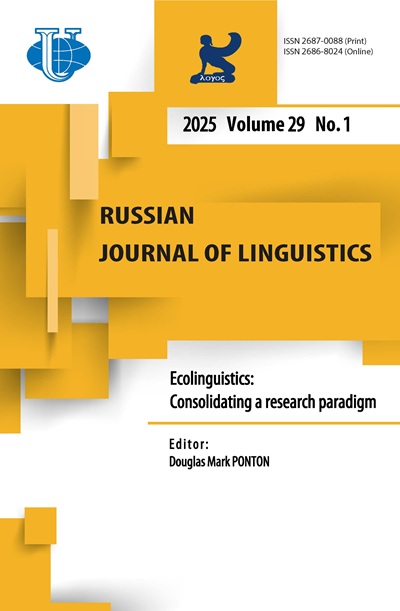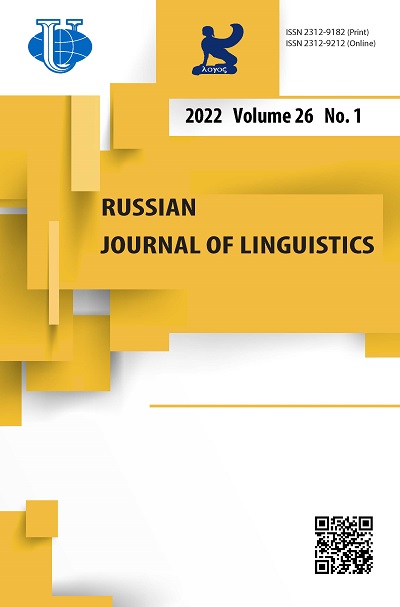Структурный и смысловой изоморфизм и алломорфизм болгарских, русских и английских устойчивых выражений: опыт сопоставительно-типологического исследования
- Авторы: Лаврова Н.А.1, Козьмин А.О.2
-
Учреждения:
- Московский педагогический государственный университет
- Московский государственный институт международных отношений (университет) МИД России
- Выпуск: Том 26, № 1 (2022)
- Страницы: 95-115
- Раздел: Статьи
- URL: https://journals.rudn.ru/linguistics/article/view/30641
- DOI: https://doi.org/10.22363/2687-0088-26443
Цитировать
Полный текст
Аннотация
Актуальность исследования обусловлена взаимообогащением разных лингвокультур устойчивыми выражениями, отражающими особенности культуры и быта определённой лингвокультуры. Проблема исследования заключается в мнимой межъязыковой эквивалентности многих устойчивых выражений, которые на смысловом и концептуальном уровне обнаруживают культурно-семантические компоненты, отсутствующие в словарных источниках. Изучение фразеофонда в сопоставительно-типологическом аспекте позволяет на контрасте показать общие и различные аспекты языковой и понятийной картин мира определенной лингвокультуры. Цель исследования - установить степень изо- и алломорфизма устойчивых выражений в русском, болгарском и английском языках, а также проанализировать факторы, которые влияют на степень типологического сходства устойчивых выражений в трех языках. Исследование проводилось в два этапа. На первом этапе материалом исследования послужило 4000 устойчивых выражений, отобранных методом случайной выборки из болгарских, русских и английских словарей устойчивых выражений (по 1334 фразеологизма из каждого словаря). В сопоставительных целях отобранные идиомы были поделены на 5 лексико-тематических групп. На втором этапе методом стратифицированной и квотной выборки в каждую группу было отобрано по 850 идиом. Для подсчета частотности опорных слов в составе устойчивых выражений использовалась программа статистической обработки данных SPSS. Результаты исследования обнаружили, что основными факторами, которые влияют на степень изоморфизма и алломорфизма между идиомами из трех анализируемых языков, являются (1) типологическое сходство и (2) генетическое родство между болгарским и русским языками, (3) заимствования из английского в болгарский и русский, (4) заимствования из русского в болгарский, (5) общий фразеофонд и (6) некоторые экстралингвистические факторы, например, наличие определенного количества функциональных частей предметов. Результаты исследования вносят вклад в сопоставительную фразеологию, ареальную и контрастивную типологию и контактологию.
Ключевые слова
Об авторах
Наталия Александровна Лаврова
Московский педагогический государственный университет
Автор, ответственный за переписку.
Email: na.lavrova@mpgu.su
доктор филологических наук, доцент, профессор кафедры фонетики и лексики английского языка Россия, 119991, Москва, ул. Малая Пироговская, д. 1, стр. 1
Александр Олегович Козьмин
Московский государственный институт международных отношений (университет) МИД России
Email: a.kozmin@inno.mgimo.ru
кандидат филологических наук, доцент кафедры английского языка № 3 факультета международной журналистики Россия, 119454, Москва, проспект Вернадского, 76
Список литературы
- Arakin, Vladimir. 2005. A Comparative Typology of Russian and English. Moscow: FIZMATLIT Publishing house. (In Russ.)
- Bagasheva, Alexandra. 2017. Cultural conceptualisations of MOUTH, LIPS, TONGUE and TEETH in Bulgarian and English. In Farzad Sharifian (ed.), Advances in cultural linguistics, 189-221. London: Routledge. https://doi.org/10.1007/978-981-10-4056-6_10
- Benczes, Réka. 2019. Rhyme over Reason: Phonological Motivation in English. Cambridge: Cambridge University Press. https://doi.org/10.1017/9781108649131
- Bilá, Magdaléna & Svetlana Ivanova. 2020. Language, culture and ideology in discursive practices. Russian Journal of Linguistics 24(2). 219-252. https://doi.org/10.22363/2687-0088-2020-24-2-219-252
- Bylinina, Lisa & Rick Nouwen. 2020. Numeral semantics. Language and Linguistics Compass 14(8). 1-18. https://doi.org/10.1111/lnc3.12390
- Cherneva, Nad’a. 2002. Semantics and Symbolism of Numbers in the National Worldview (on the Basis of Russian and Bulgarian Phraseology). Avtoref. kand. filol. nauk. Moscow. (In Russ.)
- Diedrichsen, Elke. 2020. Linguistic expressions as cultural units. How a cultural approach to language can facilitate the description of modern means of communication and expression. International Journal of Language and Culture 7(1). 121-145. https://doi.org/10.1075/ijolc.00030.die
- Goshkheteliani, Irine. 2019. Culture as reflected in Somatic idioms. Filolog 20 (20). 17-33. https://doi.org/10.21618/fil1920017g
- Hristova, Margarita & Dragomir Tzukev. 2018. Multi-speed innovations in support of individual development. Journal of Pedagogy and Education Management 2. 112-124.
- Ivanova, Elena. 2019. Contrastive analysis of Bulgarian and Russian syntax peculiarities. Slověne 8(1). 554-563. https://doi.org/10.31168/2305-6754.2019.8.1.22
- Karpov, Vladimir. 2020. The Bulgarian Language. Moscow: Lenand Publishing house.
- Kozlova, Lyubov. 2020. Metaphor as the reflection of culture determined cognition. Russian Journal of Linguistics 24 (4). 899-925. https://doi.org/10.22363/2687-0088-2020-24-4-899-925
- Kononenko, Irina. 2020. Cross-cultural communication - lost in translation: A corpus study. Russian Journal of Linguistics 24 (4). 926-944. https://doi.org/10.22363/2687-0088-2020-24-4-926-944
- Lakshmi, Bh V N & Abdullah Hamoud A. Al-Fauzanb. 2019. Idioms and culture: Exploring the inter-influence between English and other languages. Humanities & Social Sciences Reviews 7(6).131-138. https://doi.org/10.18510/hssr.2019.7627
- Lavrova, Nataliya & Elena Nikulina. 2020. Advanced Russian EFL Learners’ Awareness of Idiomatic Synonymy, Antonymy, and Polysemy. Journal of Language and Education 6(4). 105-120. https://doi.org/https://doi.org/10.17323/jle.2020.9689
- Lavrova, Nataliya & Elena Nikulina. 2020. Predictors of correct interpretation of English and Bulgarian idioms by Russian speakers. Russian Journal of Linguistics 24 (4). 831-857. https://doi.org/10.22363/2687-0088-2020-24-4-831-857
- Maslov, Jurij. 1981. Bulgarian Grammar. Moscow: Visshsaya Shkola Publishing house. (In Russ.)
- Mokienko, Valerij. 1980. Slavonic Phraseology. Moscow: Visshaya Shkola Publishing house. (In Russ.)
- Mokienko, Valerij. 1983. On the origin of phraseological Germanisms in Slavonic languages. Slavonic and Balkan Linguistics. Lexicological Problems. 101-110. (In Russ.)
- Nelyubova, Natalia, Syomina, Polina & Vitalija Kazlauskiene. 2020. Gourmandise in the hierarchy of values: A case study of French and Belgian proverbs and sayings. Russian Journal of Linguistics 24 (4). 969-990. https://doi.org/10.22363/2687-0088-2020-24-4-969-990
- Peeters, Bert. 2016. Applied ETHNOLINGUISTICS is cultural linguistics, but is its CULTURAL LINGUISTICS? International Journal of Language and Culture 3(2). 137-160
- Piirainen, Elisabeth. 2005. Europeanism, internationalism or something else? Proposal for a cross-linguistic and cross-cultural research project on widespread idioms in Europe and beyond. Hermes, Journal of Linguistics 3. 45-75. https://doi.org/10.7146/hjlcb.v18i35.25816
- Rafatbakhsh, Elaheh & Alireza Ahmadi. 2019. A thematic corpus-based study of idioms in the Corpus of Contemporary American English. Asian-Pacific Journal of Second and Foreign Language Education 4 (11). 1-21. https://doi.org/10.1186/s40862-019-0076-4
- Senkbeil, Karsten. 2020. Idioms in intercultural communication. A cognitive and pragmatic perspective. International Journal of Language and Culture 7(1). 38-62. https://doi.org/10.1075/ijolc.00026.sen
- Sharifian, Farzad. 2017. Cultural Linguistics: Cultural Conceptualisations and Language. Amsterdam/Philadelphia: John Benjamins Publishing Company.
- Teliya, Veronika. 1996. Russian Phraseology. Semantic, Pragmatic and Linguacultural Aspects. Moscow: Languages of Russian Culture Publishing house. (In Russ.)
- Torop, Peeter. 2015. Cultural semiotics. In Farzad Sharifian (ed.), Advances in cultural linguistics, 170-180. London: Routledge.
- Vereshchagin, Jevgenij & Vitalij Kostomarov. 1982. National and cultural semantics of Russian phraseologisms. Dictionaries and Linguacultural Studies. 89-97. (In Russ.)
- Wang, Yan. 2017. On Cultural Connotations of English Idioms. Advances in Social Science, Education and Humanities Research 121. 156-159. https://doi.org/10.2991/ichssr-17.2017.31
- Wągiel, Marcin & Pavel Caha. 2020. Universal semantic feature and the typology of numerals. Catalan Journal of Linguistics 19. 199-229. https://doi.org/10.5565/rev/catjl.296
- Wolf, Hans.-Georg. 2015. Language and culture in intercultural communication. In Farzad Sharifian (ed.), Advances in cultural linguistics, 445-459. London: Routledge.
- Ankova-Nicheva, Keti. 1993. Nov Frazeologichen Rechnik na Bylgarskija Ezik (Phraseological Dictionary of Bulgarian). Sophia: Sv. Kliment Ohridski.
- Banova, Marija & Stamena Dimova. 2014. Frazeologichen Rechnik na Bylgarskija Ezik (Phraseological Dictionary of the Bulgarian Language). Sofia: Ban Mar.
- Bernstein, Samuil. 1975. Bolgarsko-Russkij Slovar’ (Bulgarian-Russian dictionary). Moscow: Sovetskaja Enziklopedija.
- Birih, Alexandr, Mokienko, Valerij & Ljudmila Stepanova. 1999. Slovar’ Russkoj Fraseologii. Istoriko-etimologicheskij Spravochnik (Dictionary of Russian Phraseology. A Historico-Etymological Reference Book). Moscow: Folio Press
- Bol’shoj Frazeologicheskij Slovar’ Russkogo Yazika (Comprehensive Phraseological Dictionary of Russian). 2018. Moscow: ACT Press.
- Kunin, Alexandr. 1998. Bol’shoi Anglo-Russkii Frazeologicheskii Slovar’ (Comprehensive English-Russian Phraseological Dictionary). Moscow: Zhivoj jazik.
- Makartsev, Maxim & Tat’jana Zhernovenkova. 2012. Bolgarskij Yazik. Tematicheskij Slovar’ (Bulgarian Language. Thematic Dictionary). Moscow: Zhivoj jazik.
- Populjarnije Bolgarskije Frazeologismi (Popular Bulgarian Idioms) (electronic source). http://news.flarus.ru/?topic=6763 (accessed 28 February 2022).
- Sabeva, Radost & Zhana Zagorova. 2015. Speak Bulgarian like a Native. Bulgarian Idioms in Context: CreateSpace.
- Sakralnij Smisl Chisel v Verovanijah i Uchenijah (The Sacrosanct Meaning of Numbers in Religious Denominations and Teachings). URL: https://ria.ru/20070707/68528028.html (accessed 28 February 2022).
- Chambers Dictionary of Idioms and Catch Phrases. 1995. Edinburgh: Chambers Harrap Publishers Ltd.
- Cambridge International Dictionary of Idioms. 1998. Cambridge: Cambridge University Press.
- Chambers English Idioms. 1995. Edinburgh: Chambers Harrap Publishers Ltd.
- Collins Cobuild Dictionary of Idioms. 1995. London: Harper Collins.
- Collins Dictionary. URL: https://www.collinsdictionary.com/dictionary/english/one-swallow-doesnt-make-a-summer (accessed 28 February 2022).
- Farlex Idioms and Slang Dictionary. URL: https://www.amazon.com/Farlex-Idioms-Slang-Dictionary/dp/1539588874 (accessed 28 February 2022).
- Idioms Online. URL: https://www.idioms.online/up-the-creek/ (accessed 28 February 2022).
- Longman Dictionary of English Idioms. 1998. London: Addison Wesley Longman Dictionaries.
- McGraw-Hill Dictionary of American Idioms and Phrasal Verbs. 2006. New York: McGraw Hill Professional.
- Oxford Dictionary of English. 2019. Oxford: Oxford University Press.
- The American Heritage Dictionary of Idioms. 2003. Boston: Houghton Mifflin Harcourt.
- The Macquarie Dictionary. 1997. Sydney: Macquairie Library.
- The Oxford Dictionary of Idioms. 2004. Oxford: Oxford University Press.
- The Penguin Dictionary of English Idioms. 2001. London: Penguin.
- Urban Dictionary. URL: https://www.urbandictionary.com/define.php?term=squeezed%20lemon (accessed 28 February 2022).

















